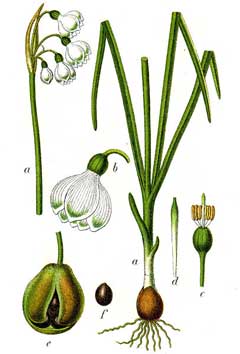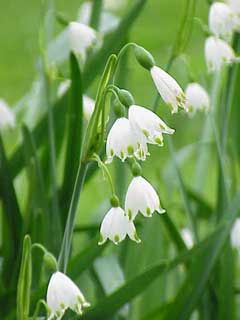 |
|
http://commons.wikimedia.org/wiki/File:Leucojum_aestivum_Sturm48.jpg |
 |
| biolib.de |
Translate this page:
Summary
Bloom Color: White. Main Bloom Time: Late spring. Form: Upright or erect.
Physical Characteristics

 Leucojum aestivum is a BULB growing to 0.5 m (1ft 8in) by 0.1 m (0ft 4in) at a medium rate.
Leucojum aestivum is a BULB growing to 0.5 m (1ft 8in) by 0.1 m (0ft 4in) at a medium rate.
See above for USDA hardiness. It is hardy to UK zone 4 and is not frost tender. It is in flower in May, and the seeds ripen in July. The species is hermaphrodite (has both male and female organs) and is pollinated by Bees.
Suitable for: light (sandy), medium (loamy) and heavy (clay) soils and can grow in heavy clay soil. Suitable pH: neutral and basic (mildly alkaline) soils. It can grow in semi-shade (light woodland) or no shade. It prefers moist or wet soil.
UK Hardiness Map
US Hardiness Map
Synonyms
Plant Habitats
Woodland Garden Sunny Edge; Dappled Shade; Meadow; Bog Garden;
Edible Uses
Edible Parts: Root
Edible Uses:
Bulb - cooked[105]. I have some reservations about this report, though no records of the plant being poisonous have been found so far.
References More on Edible Uses
Medicinal Uses
Plants For A Future can not take any responsibility for any adverse effects from the use of plants. Always seek advice from a professional before using a plant medicinally.
None known
References More on Medicinal Uses
The Bookshop: Edible Plant Books
Our Latest books on Perennial Plants For Food Forests and Permaculture Gardens in paperback or digital formats.

Edible Tropical Plants
Food Forest Plants for Hotter Conditions: 250+ Plants For Tropical Food Forests & Permaculture Gardens.
More

Edible Temperate Plants
Plants for Your Food Forest: 500 Plants for Temperate Food Forests & Permaculture Gardens.
More

More Books
PFAF have eight books available in paperback and digital formats. Browse the shop for more information.
Shop Now
Other Uses
References More on Other Uses
Cultivation details
Landscape Uses:Border, Container, Foundation, Massing, Rock garden, Specimen, Woodland garden. Easily grown in ordinary garden soil[1]. It does well in a moist heavy soil in full sun or partial shade[1, 17, 31, 90] and is happy in water-logged conditions[90]. The dormant bulbs are fairly hardy and will withstand soil temperatures down to at least -5°c[214]. Plants can be naturalized in damp rough grass[200]. Flowers are produced within 4 - 5 years from seed. The seedpods are swollen and filled with air so that they can be dispersed by floating in water[90]. Members of this genus are rarely if ever troubled by browsing deer or rabbits[233]. Special Features:Attractive foliage, Naturalizing, Suitable for cut flowers.
References Carbon Farming Information and Carbon Sequestration Information
Temperature Converter
Type a value in the Celsius field to convert the value to Fahrenheit:
Fahrenheit:
The PFAF Bookshop
Plants For A Future have a number of books available in paperback and digital form. Book titles include Edible Plants, Edible Perennials, Edible Trees,Edible Shrubs, Woodland Gardening, and Temperate Food Forest Plants. Our new book is Food Forest Plants For Hotter Conditions (Tropical and Sub-Tropical).
Shop Now
Plant Propagation
The seed is best sown as soon as it is ripe in a well-drained soil in a cold frame. Stored seed requires 2 - 3 months cold stratification, it should then germinate in 2 - 4 weeks at 10°c[134]. Sow the seed thinly so that the seedlings can be allowed to grow on undisturbed in the pots for their first year of growth. Give them an occasional weak liquid feed to ensure that they do not become nutrient deficient. Pot up the small bulbs when dormant, planting 2 - 3 bulbs in each pot. Grow them on for another 2 - 3 years before planting them out. Division of offsets in September/October. It is best done as soon as the foliage ripens[1]. Scooping the bulbs.
Other Names
If available other names are mentioned here
Native Plant Search
Search over 900 plants ideal for food forests and permaculture gardens. Filter to search native plants to your area. The plants selected are the plants in our book 'Plants For Your Food Forest: 500 Plants for Temperate Food Forests and Permaculture Gardens, as well as plants chosen for our forthcoming related books for Tropical/Hot Wet Climates and Mediterranean/Hot Dry Climates. Native Plant Search
Found In
Countries where the plant has been found are listed here if the information is available
Weed Potential
Right plant wrong place. We are currently updating this section.
Please note that a plant may be invasive in one area but may not in your area so it’s worth checking.
Conservation Status
IUCN Red List of Threatened Plants Status :

Growth: S = slow M = medium F = fast. Soil: L = light (sandy) M = medium H = heavy (clay). pH: A = acid N = neutral B = basic (alkaline). Shade: F = full shade S = semi-shade N = no shade. Moisture: D = dry M = Moist We = wet Wa = water.

Expert comment
Author
L.
Botanical References
17200
Links / References
For a list of references used on this page please go here
Readers comment
© 2010, Plants For A Future. Plants For A Future is a charitable company limited by guarantee, registered in England and Wales. Charity No. 1057719, Company No. 3204567.